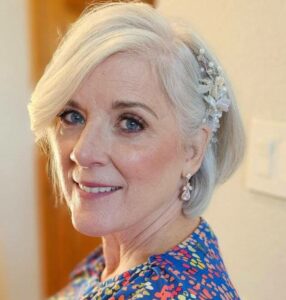Missionary service is the only way to truly prove your dedication to Jesus Christ. Or so I mistakenly thought—and upon which I built two decades of my life. To not be overseas was to be living in rebellion against prayers prayed and commitments made.
To not be overseas meant ignoring a calling, the calling made specific for me at a vulnerable age of 20, when I began what I call “my real life” at St. Paul Bible College from 1979-83.
It would take a red chair to set me straight and to turn me into a child of God again.
We returned from missionary service on February 29 in the year 2000, an odd day in a momentous year for us. The millennium was in full swing around us, yet my heart remained back in Mongolia, buried in the zinnia patch outside of our plastered straw bale house, a house we made out of the Gobi Desert, on a dusty patch of earth. It had not been an easy life, but a good one.
Being back was not good—as far as I was concerned—a tragedy with layers of why it was so.
While my aunt and uncle took us into their home, we started new routines and ways to make it through the day. I remember the first full meal I made in her kitchen. I was at a loss to know what to make, so I made a meal of cabbage, fried potatoes and sausage, something we often made on the other side of the earth. At my aunt and uncle’s, I learned how to use the remote control and how to schedule in a walk around the neighborhood in the evening. Keep moving. Don’t feel.
When renters moved out of our old home in South Dakota on 241 Polk Street, we sought to return to the familiar while we figured out what to do—Next?
Bill was lighter on his feet than I for he finished grieving the loss of our half-built ministry before we left it. He was ready to start another—and not one that meant learning a new language. He had searched the Scriptures back in Mongolia during the getting-ready-to-leave-but-I-hope-we-stay-months.
Bill announced one day while I was in the kitchen preparing the evening meal, “There’s only one place in the Bible that connects a spiritual calling to a place,” he said. “The other references are about being called to conform to the likeness of Christ. In character. In our actions.”
I looked out the little kitchen window, only the back fence in view. His words were no solace for me. I was a missionary. I had a people. I had a place.
We needed furniture to restock our lives in South Dakota. Bed, washer, dryer, places to sit. My aunt organized a “furniture drive” in Bloomington, Minnesota. We went from house to house with a rented trailer and took furniture cast-offs from nice people.
At one senior living apartment, a woman gave us a Victorian chair in red velvet, with a tall back detailed with 30 buttons on the back and in the inside of the arms “I’ve had this chair for over 30 years…I met the Lord in this chair or devotions. But we’ve moved to this smaller apartment, and I sense God wants you to have it.”
I received it with respect—as it was described—a sacred meeting place for her heart to meet and greet the Lord. She watched as it was packed into the truck. We pulled the door shut, climbed in and drove off.
I put the chair in my South Dakota bedroom but walked around it, dusted it, and rarely sat in it.
When God revealed our next meeting location for ministry, the red chair went with us. It was placed next to our bed in the master bedroom on Gendale Street, Farmington, Missouri. It fit on my side of the bed.
As we got our children situated in their schools and activities, the house was empty part of the day and this mother could finally let down and emotionally heal.
By now, we had the visitor, a man in his late 50s with white hair and short trimmed white beard. Not a Santa Claus, just a stranger who found us when the Youth for Christ “home-group” was held at our place. Bible Study was underway in our living room when he rang the bell and asked to join us.
“Do you know who that is?” I whispered Bill. He shook his head.
The man listened politely during the Bible Study and lingered on the sofa until all the teens had left for home and our oldest two for their rooms. The man turned to Mary and engaged her in conversation using her name.
She told me in private later that he had reassured her that she was still grieving the loss of Mongolia—but that everything would work out in the God’s time.
Mary remarked, only 12 years old at the time, that he knew her heart and referenced things she had only thought and prayed about, things no one else knew.
With this man’s visit, Mary’s personal adjustment to life in the U.S. was underway. She was convinced the man had been an angel. Mary would have to let go of the Mongolian language, forget her free life in Mongolia where she roamed the outskirts of our neighborhood with Tsatsanna. She no longer observed Ulaanbaatar from the highest hill with goats on her heels. The United States was her home now, and she would make the best of it.
I, however, was a firey ball of angst. The turmoil came to a head when I located all the tokens of my past and threw them into one large pile in the 3-season room. Amongst the treasures were Mongolian pretties, my diaries since childhood, and my piano books. I was going to set a match to the mess.
I argued with myself. “Am I the Mongolia Lori or the PreMongolia Lori?” Everything was meaningless. So, why not set it all on fire?
I never intended to ignite the fire indoors. Of course, I would haul it all outside to burn. It was time to start fresh!
Thankfully, Bill came home before I carried through with my plan and stopped me. Our conversation turned toward the character of God. I remember asking, “Is God punishing me for being independent and insensitive to your needs?”
You see, while I had experienced the highlights of the missionary life, translating Bible Studies and finding balance of home and ministry, Bill was dying inside over and over again with each trial and with each reminder that his language was inadequate.
But now, he turned to me and my need to understand God’s ways. He challenged my thinking about how God the Father deals with his children.
That night, I had it out with God. “You tricked me. You said everything would be alright—that we could stay.”
The Spirit replied, “No I told you everything would be alright and you added the part “and we can stay.”
“Well then, where do you want me?” I asked in a raised voice.
His answer was quiet and clear to my spirit. “In the red chair.”
I knew what it meant, but how could I meet Him in the chair after my doubt and such disrespectful accusations?
I slept on it.
The next morning when everyone had left the house for work or school, I knew I had two hours before lunch. I sat in the red chair. I opened the Bible and God met me there.
I learned again that I am a child of His. And because I am His, I am given all the benefits of being one of His, not because of my service for Him in faraway places but simply because of his good Father-ness. Any human could depend on His fatherly protection and guidance. Someone who could never leave their home or their bed, or example, someone paralyzed or incapacitated may expect His loving care. No acceptance into His family is based upon service or location.
Red chair moments and hours reframed my thinking, my heart, my friendship with the Lord.
Now nearly 20 years later, the velvet is faded and worn. Random gashes to the wood frame appeared in a recent move. So. It is time to give the chair a proper tribute before it is freshened up with stain and new material. Blue or gray, tan or charcoal, it will always be my Red Chair.
–February 2019



